11th May 2017 (Thursday) More pictures in Edinburgh after the Castle
Scot Guard
A Walk Down the Royal Mile - Lawnmarket
Leaving Castle Hill, our walk now takes us down to the Lawnmarket, which is the oldest part of the Old Town... The original settlement here developed both within the shadow and protection of the Castle. The Lawnmarket's name derives from "land market" where produce from the surrounding countryside was sold. A cloth market was also established here in 1477, one of 15 market sites chartered by James III within the city. This vibrant and colourful market continued to trade here until around the late 1700s. The Lawnmarket also boasts some of the best preserved examples of closes, courtyards and 'land' developments that remain within the city...
Heritage of Scotland 459-461 Lawnmarket. The Heritage of Scotland shop. All kilts, kilt accessories and Scotland related gifts in one place, located just down from Edinburgh Castle. They offer a wide selection of Scottish souvenirs, kilts, tartans and everything that is Scottish
Deacon Brodie at the Deacon's House Café
A real life cabinet-maker, William Brodie, was elected a Deacon Councillor of the City of Edinburgh in 1781. By day he was an outwardly respectable citizen and pillar of society, but by "night he was a gambler, a thief, dissipated and licentious." To support his lavish lifestyle Brodie would copy the keys of his wealthy clients and return at night to rob them. He escaped to Amsterdam in the Netherlands after being recognised at the scene of one of his crimes only to be caught and returned to Scotland
He was hanged from the city's new gallows at the Tolbooth on 1 October 1788. Such was the public interest in the case that it was said to have been attended by a crowd of over 25,000.
However, the story does not end there. The story goes that Brodie bribed the hangman to ignore a metal collar he was wearing and that he had also inserted a flexible tube into his throat in an attempt to prevent the drop from being fatal. Immediately after the execution, Brodie's body was spirited away to a rendevouz with a French surgeon in the hope that it might be revived. Here however the plot thickens even further . While it is claimed that Brodie did indeed perish and that his body was buried in an unmarked grave in Buccleuch Parish Church, rumours however were later to circulate in the city that he had been seen alive and well and living in Europe
We stopped for lunch here. Lovely atmosphere, friendly staff and good food
Traditional Scottish ambience. Highly recommended
Street signs
Parliament House
The Scottish Parliament moved from the Great Hall at Edinburgh Castle into new purpose built accommodation in 1639. That accommodation was Parliament Hall, which is now part of Parliament House. The Union of the Scottish and English Parliaments in 1707 made the building redundant and it is now houses the Scottish Supreme Courts (High Court of Justiciary and the Court of Session)
St Giles (patron saint of cripples, lepers and nursing mothers) is the patron saint of Edinburgh. The church's crowned spire makes it instantly recognisable on the Edinburgh skyline
St Giles Cathedral Entrance
Interior views
Within are exquisite stained glass windows, a variety of monuments and memorials and the Chapel of the Order of the Thistle, the most famous Scottish order of chivalry, established by James VI in 1687
Statue of the reformation Calvinist minister John Knox
Stained glass window
Edinburgh School of English, 271 Canongate, The Royal Mile
The Royal Mile, High Street and Canongate: This historic backbone of the Old Town is an old favourite for gifts including Scottish crafts, cashmere and whisky, alongside some of Edinburgh's oldest taverns and eateries
Flower of Scotland
Simply Scottish
More shops: Sugarhome Sandwiches, Celtic designs, etc.
The Canongate forms part of what is now called the 'Royal Mile' running from Edinburgh Castle down to Holyrood Palace
The Queen's Gallery
To the right of Abbey Strand is The Queen's Gallery. The Queen's Gallery forms part of the Palace of Holyroodhouse complex. It was opened in 2002 by Queen Elizabeth II as part of her Golden Jubilee celebrations. The Gallery forms part of the Holyroodhouse complex and and is used to exhibit works from the Royal Collection (Admission charge applies)
This Victorian building was originally built as Holyrood Free Church (a congregation of the Free Church of Scotland, then from 1900 United Free Church of Scotland), but was last used for worship in 1915. Prior to its conversion to become the Queen's Gallery the building was used as a storeroom
Cemetery in Edinburgh
I don't know the name of this cemetery but the modern building in the distance on the left is the Scottish Parliament Building. The distinctive hill and rockface in the background is part of Holyrood Park, leading up to Arthur's Seat
Always antifascist!
Outside the Omni Centre (to the right of pic). Leith Walk is in the distance
Playhouse Theatre Edinburgh
The Edinburgh Playhouse is the largest working theatre in the UK in terms of audience capacity, seating 3,059 people over three levels. Originally used as a cinema, nowadays the venue is used for large scale touring musical productions. The theatre is managed by the Ambassadors Theatre Group (ATG) who use it to house a wide variety of different performances each year. The building itself is a Grade I Listed Building and was originally modelled on the Roxy Cinema in New York
York Place. The Conan Doyle Pub, named after
author Sir Arthur Conan Doyle is pictured here
St. Paul & St. George's Church, Broughton Street
Queen Street. In front of The Scottish National Portrait Gallery
The Scottish National Portrait Gallery is one of Edinburgh’s most remarkable buildings – a great red sandstone neo-gothic palace which sits proudly on the city’s skyline. The Gallery was designed by Sir Robert Rowand Anderson as a shrine for Scotland’s heroes and heroines. It opened to the public in 1889 as the world’s first purpose-built portrait gallery
More pics in Queen Street in the heart of the city
North St Andrew Street Sign
Former building at St. Andrew Street, converted to luxury hotel
Edinburgh Bus Station
I don't know what this building used to be, it now seems
to be used as a café, but it is in St. Andrew Square
Here I was in South St. Andrew Street, looking towards
Princes Street, Waverley Mall, and The Old Town in the background
The Balmoral Hotel, Princes Street. Very beautiful building
The Scott Monument, a Victorian Gothic monument to Scottish author Sir Walter Scott. It is the largest monument to a writer in the world. It stands opposite the Jenners department store on Princes Street and near to Edinburgh Waverley Railway Station, which is named after Scott's Waverley novels
The Royal Scottish Academy of Art & Architecture, seen from Princes Street
Princes Street Gardens, a public park in the centre of the city, in the shadow of Edinburgh Castle. It is divided into three parts. To the east of The Mound and the Scottish National Gallery is East Princes Street Gardens, while to its west is, unsurprisingly, West Princes Street Gardens. The latter is further subdivided by the railway lines running from Waverley Station into the main area to their north and the open areas around the lower slopes of Edinburgh Castle Rock to their south
THE CALL, Scottish-American War Memorial
The Scottish American Memorial, or Scots American War Memorial, is in West Princes Street Gardens in Edinburgh. It was called "The Call 1914", and it was erected in 1927 and shows a kilted infantryman looking towards Castle Rock. Behind the main statue is a frieze showing queues of men answering the call by following a kilted pipe band. The memorial was given by Scottish-Americans to honour Scots who had served in the first World War.
It is designated a Category B listed building by Historic Scotland
The Ross Fountain, a cast-iron structure located in West Princes Street Gardens
Bronze soldier bear statue of Wojtek, located on the terrace walk at the west end of Princes Street Gardens, on the south side of the main terrace at the corner of a pathway leading down into the main area of the gardens
Statue in honor of WWII’s Wojtek, the beer-drinking bear who saw action during the Second World War... The unusual but touching story of the Soldier Bear started in the Middle East in 1943.
Wojtek was a Syrian brown bear orphaned after hunters killed his mother. It was during the trip of the Polish II Corps through the mountainous region of Persia [Iran] that they came upon the future soldier bear, traded to them by a shepherd boy
The Polish soldiers went on to adopt him and train him to carry mortar rounds. With the Polish troops, the soldier bear grew from a very small cub to a big but amiable full-grown bear. He also developed particular tastes for drinking beer and eating lit cigarettes.
However, Wojtek’s adoptive “parents” were soon faced with a dilemma — they were about to enter the Italian war zone and it was a rule that no animals were to accompany soldiers during the fighting. To solve this, they enlisted Wojtek. The soldier bear was given his own name [Wojtek is a common Polish name which means he who enjoys war or joyful warrior], rank and number. He even had his own payroll and own food ration which was double that of what a regular soldier got.
Wojtek went on to take an active part in the Italian campaign, particularly during the monumental Battle of Monte Cassino [where he was said to help by moving crates of ammunition], as an official member of the 22nd Artillery Supply Company
The soldier bear eventually went on to become his company’s mascot. When the company the soldier bear was a member of was demobilized in 1947, Wojtek stayed in Scotland like many of the Polish soldiers who opted to stay in the UK. He became a resident at Edinburgh Zoo and spent his days entertaining people. Polish ex-servicemen continued to visit the soldier bear in his new home often speaking to him in their native language.
His death in 1963 was met with so much sadness by those who knew him and was largely publicized with reports about the unfortunate event circulating in TV and radio.
The memorial bears the inscription: “In memory of the Polish men and women who fought ‘for your freedom and ours'”. Additionally, it features a Polish soldier walking alongside the soldier bear. The touching bronze Soldier Bear Statue was created by sculptor Allan Beattie Heriot
World War I Remembrance statue: The Scottish American Memorial
It was called "The Call 1914", and it was erected in 1927 and shows a kilted infantryman looking towards Castle Rock. Behind the main statue is a frieze showing queues of men answering the call by following a kilted pipe band. The memorial was given by Scottish-Americans to honour Scots who had served in the first World War
Behind me the monument to the Royal Scots Greys by Birnie Rhind.
Royal Scots Grey Statue shows a mounted soldier from the Royal Scots Greys Regiment. The regiment was founded in 1678 and existed until 1971 when combined with another regiment to form the The Royal Scots Dragoon Guards
A memorial plaque on one of the many park benches. In loving memory of John Wilson Gardiner of Edinburgh. Died August 23rd, 1974. He loved his city and his country
The next day: 2017 European Rugby Challenge Cup final.
BT Murrayfield - Friday, 12 May 2017 (20.00)
BT Murrayfield - Friday, 12 May 2017 (20.00)
Redwood Bistro: 1 Meadow Place Road, located at a busy roundabout in Edinburgh
These flats are in the Townhead area of Glasgow
I really enjoyed Edinburgh. It was everything I wanted of a big city in Scotland...


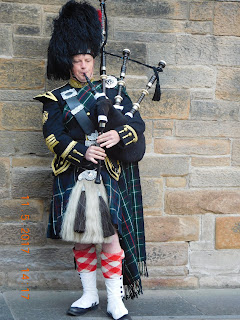







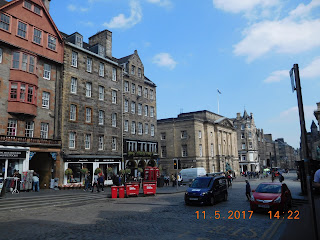

















































































































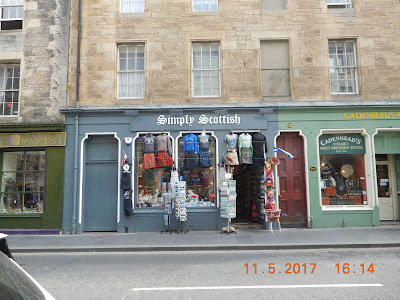






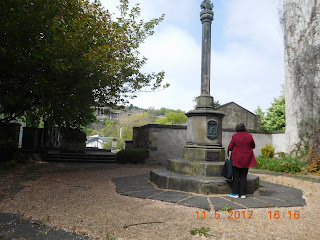




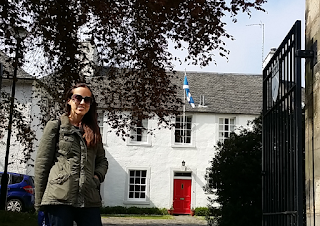



























































































































































































.jpg)

You'll catch the eye of all the ladies when you hit the clubs, walk into the pub or stroll down the street in the black Sexy Kilt for Hot Men,,,,
ReplyDeletesexy kilts for men